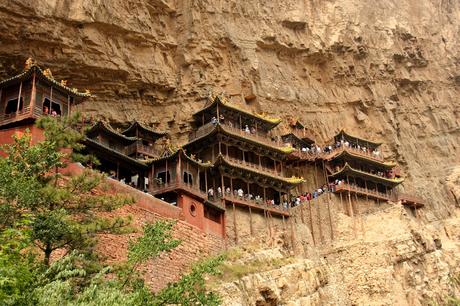
Hanging Monastery stands at the foot of Mt. Hengshan, 5 kilometers (3 miles) south of Hunyuan County, and 65 kilometers (40 miles) from downtown Datong City. Since it hangs on the west cliff of Jinxia Gorge more than 50 meters above the ground, it is called Hanging Monastery.The temple was constructed by drilling holes into the cliffside into which the poles that hold up the temples are set. Interestingly the temple is dedicated to not just one religion, but three, with Confucianism, Taoism and Buddhism all practiced within the temple and represented in 78 statues and carvings throughout the temple.The Hanging Temple was built in 491 in the reign of Beiwei Dynasty, has survived more than 1,500 years. This extant monastery was rebuilt in Ming Dynasty and Qing Dynasty. There are now about 40 rooms and structures linked by a creative system of pillars, walkways and posts. There are totally over 80 religious statues of copper, iron, rock and clay. The Hanging Monastery is famous internationally both for its architecture and religious heritage. The Hanging Monastery is itself an architectural wonder! A featuring mechanical theory was used to work on the building of the framework. The crossbeams were half-put inside the rock as the solid bade and the rock in back became its strong support. The most uniqueness of the the Hanging Monastery is its combination of Buddhism, Taoism and Confucianism! They live happily together, rarely seen in the world.
 god, Hanging Monastery, India, vikasacharya
god, Hanging Monastery, India, vikasacharya
